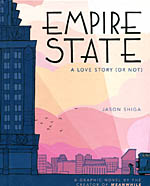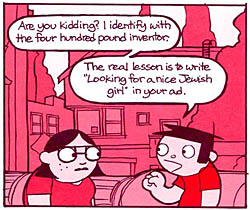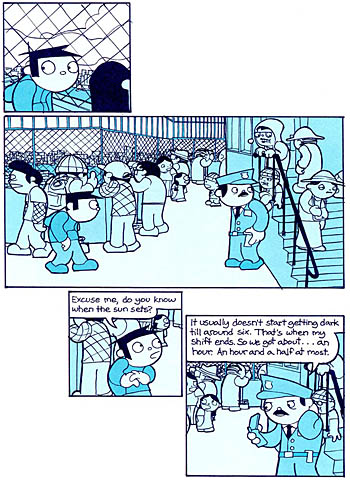 By Jason Shiga
By Jason Shiga
144 pages, color
Published by Abrams Comicarts
Jason Shiga is the sort of comic creator with whom you never know what you’re going to get next. Sometimes he plays with format and linearity, in books like Meanwhile and Hello World. Other times they’re more grounded but twist the world around them, telling crime investigation stories with librarians in Bookhunter or a unique locked-room mystery in Fleep. Empire State is probably his most standard, by-the-book comic since his Xeric Grant funded Double Happiness. But even here, it feels like Shiga can’t help but tinker with the story a bit and make something stand out from the rest. And in the case of Empire State: A Love Story (Or Not), it’s the first time where I feel like that spark of difference doesn’t quite work.
On its surface, Empire State appears simple enough. Jimmy and Sara were best friends in Oakland, but Sara finally moved to New York City to work for a publishing company. When Jimmy decides that Sara’s the one true love for him, he figures it’s time to try and re-enact Sleepless in Seattle and send her a letter asking to please meet on the top of the Empire State Building if she feels about him the way he feels about her. And then, letter sent, he heads off to New York to find his romantic ending.
 The one way where Empire State deviates from being an utter romantic cliche is in the character of Jimmy. Because unlike most characters in stories like this, Jimmy isn’t just a little over his head. He’s completely out of his depth. Jimmy is depicted as so ridiculously clueless that it shifts the character away from charming and into pathetic. Shiga gives us some early clues that Jimmy is not ready for the real world—at the age of 25 he still signs his paychecks over to his mother, who then gives him an allowance—but it’s once Jimmy sets off on his trip to Sara that you realize that this is someone who probably shouldn’t even be allowed into vast sections of Oakland, let alone traveling to New York. This is a character who doesn’t realize that passports aren’t needed for domestic flights, who’s never used a mobile phone, and wants to be a web designer but clearly doesn’t know the first thing about web technology post-1995. He giggles when he hears someone swear, like a little child, and it’s right around that point where you begin to realize that Jimmy might physically be an adult, but emotionally he’s never grown up.
The one way where Empire State deviates from being an utter romantic cliche is in the character of Jimmy. Because unlike most characters in stories like this, Jimmy isn’t just a little over his head. He’s completely out of his depth. Jimmy is depicted as so ridiculously clueless that it shifts the character away from charming and into pathetic. Shiga gives us some early clues that Jimmy is not ready for the real world—at the age of 25 he still signs his paychecks over to his mother, who then gives him an allowance—but it’s once Jimmy sets off on his trip to Sara that you realize that this is someone who probably shouldn’t even be allowed into vast sections of Oakland, let alone traveling to New York. This is a character who doesn’t realize that passports aren’t needed for domestic flights, who’s never used a mobile phone, and wants to be a web designer but clearly doesn’t know the first thing about web technology post-1995. He giggles when he hears someone swear, like a little child, and it’s right around that point where you begin to realize that Jimmy might physically be an adult, but emotionally he’s never grown up.
 The problem is, Shiga never gives a reason for Jimmy’s emotionally stunted growth, and in many ways it’s never followed up. Jimmy’s naive and clueless nature is presented to the reader as a fact, but there’s no resolution to it. It’s hard to get the impression that Jimmy’s truly grown by this experience (despite his sudden, "I feel very old" in the closing scene), and with him the main character it makes Empire State feel like a story fragment instead of a complete book. The saving grace in the writing is the character of Sara, whose caustic wit makes her scenes entertaining, even if at times she feels like she’s wandered in from an entirely different book. Her opening scene with Jimmy serves as a good bookend for their final scene, and while I get that Shiga’s trying to show us that they move in different worlds, the ever-growing gap between the pair might make you wish that we’d gotten a book all about Sara, rather than Jimmy.
The problem is, Shiga never gives a reason for Jimmy’s emotionally stunted growth, and in many ways it’s never followed up. Jimmy’s naive and clueless nature is presented to the reader as a fact, but there’s no resolution to it. It’s hard to get the impression that Jimmy’s truly grown by this experience (despite his sudden, "I feel very old" in the closing scene), and with him the main character it makes Empire State feel like a story fragment instead of a complete book. The saving grace in the writing is the character of Sara, whose caustic wit makes her scenes entertaining, even if at times she feels like she’s wandered in from an entirely different book. Her opening scene with Jimmy serves as a good bookend for their final scene, and while I get that Shiga’s trying to show us that they move in different worlds, the ever-growing gap between the pair might make you wish that we’d gotten a book all about Sara, rather than Jimmy.
I do love Shiga’s art in Empire State, with his trademark round heads and intriguing page layouts. The characters feel at times more like avatars than actual people, with their uniform body shapes and similarities. It’s only when Mark appears halfway through the book that you start to see a sharp edge, and his visual outsider nature ends up being a good contrast to the world that Jimmy understands so well. What’s fun about Shiga’s art for me, above all else, is looking in the backgrounds and picking out all of the different sorts of people wandering through. It’s people of all nationalities and looks (although all drawn in that Shiga style), and it makes the world of Empire State feel robust. The pages themselves feel almost like each panel was drawn individually and then placed onto the page in a trail, to pull your eye across from one end to the other. It’s a great look, one that rarely uses the entire page (unless specifically needing to) and it has a flow to it that few artists can achieve. John Pham colors the book in shades of red for scenes set in the past, and blue for the present, but uses different levels of the color to still provide depth and heft to the art. It’s an attractive overall look, and a nice visual tip to the reader.
Empire State ends up being a book that I wanted to like, but walked away from feeling like I’d read a flawed creation. Some readers will probably love the not-ready-for-the-world Jimmy, but others will find themselves irritated by his utter inability to move through the real world. Empire State is an interesting idea, but Shiga seems to have taken the idea of the characters existing in different worlds and taken it a little too far. For an introduction to Shiga’s comics, there are unfortunately much better options out there. Considering Shiga’s pedigree, this is ultimately a frustrating book.
Purchase Links: Amazon.com | Powell’s Books
